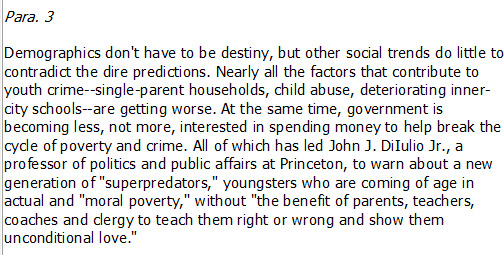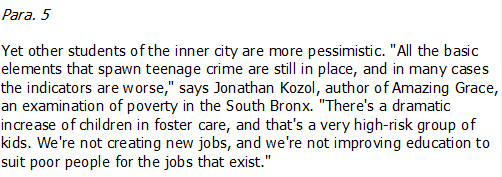- Home
- Reading Lessons
- Ielts Reading Multiple Choice
IELTS Reading Multiple Choice
Objective: IELTS reading multiple choice and skimming and scanning practice.
You won't have time in the reading test to carefully read the whole passage all of the way through, so you need to find the answers in the text quickly.
This lesson shows you how skimming and scanning can help with this in relation to answering multiple choice types questions.
Underline / highlight key words
Before you start any reading pasage, you should firstly take a look at the question stems to get an idea of what you may need to look out for.
Below is an example of one of the IELTS reading multiple choice questions you'll be looking at in this practice reading:
4. James Fox believes that the improvement in crime figures could
(a) make us complacent in the fight against crime.
(b) result in an increase in teenage violence.
(c) result in a decrease in teenage violence.
If you look at the question stem, you will see that a name is mentioned: James Fox, and if you look at all the questions below, you'll see other names mentioned e.g. John J. DiIulio, Michael Tonry.
So this immediately tells you it is a good idea to underline 'names' as you read the text. You will then be able to quickly scan the text later to find where the answers are.
The things to underline when you read the text are often nouns like names, dates, numbers or any other key words that stand out as a key topic of that paragraph.
Order of Answers in the Text
This type of question follows the order of the text. So when you have found one answer, you know that the next one will be below, and probably not too far away.
So as noted above - when you start looking at the questions, you should underline key words in the question stem to help you find the answers in the text.
4. James Fox believes that the improvement in crime figures could
(a) make us complacent in the fight against crime.
(b) result in an increase in teenage violence.
(c) result in a decrease in teenage violence.
In the computer based test, you have a highlight function so you can highlight words in yellow.
Reading in detail
When you read the text for the first time, you should focus on the topic sentences, and skim the rest of the paragraph.
But once you start answering the IELTS reading multiple choice questions and you have found where the answer is, you will need to read the text in detail in order to identify the correct choice.
IELTS READING TIP:
Do not think that just because you have found some words in the multiple choices (a, b or c) that match the words in the text that this must be the right answer.
It's usually not that simple so you must read the section where you think the answer is carefully.
IELTS Reading Multiple Choice - Practice
Now answer the questions for this reading. The words that are useful to underline have already been underlined so you can see which are the best to highlight.
Scan the reading to find those words in bold then answer the question.






Questions 1-8
Multiple Choice
Choose the correct answer.
they are impulsive and immature.
they may grow up to be criminals.
decreasing.
not changing.
18 - 24.
24 +.
result in an increase in teenage violence.
result in a decrease in teenage violence.
is not interested in solving the problem.
is not doing enough to solve the problem.
less pessimistic.
equally pessimistic.
employment and education are not the answer.
employment and education can improve the situation.
should be decreased.
is irrelevant to crime rates.
This part discusses the IELTS reading multiple choice answers. The part in italics is the section from the reading which has the answer.
(1) Young children are making criminologists nervous because
By the year 2005 they will be teenagers--a group that tends to be, in the view of Northeastern University criminologist James Alan Fox, "temporary sociopaths--impulsive and immature." If they also have easy access to guns and drugs, they can be extremely dangerous. (para. 1)
'Children' are not commiting more crime so (a) is not correct.
You may have been tempted to tick (b) because the reading mentions " impulsive and immature", but this is in reference to when they will be teenagers later in life, not the children.
(c) is correct because, as per the quote above, the concern is that when they become teenagers (grown up) they will commit these crimes.
(2) The general crime rate in the US is
For all the heartening news offered by recent crime statistics...(para. 2)
"Heartening news" means 'good news' - so the general crime rate is obviously falling as this would be good news. So the answer is (b)
(3) The age group which commits the highest rate of crime is
...14 and 17, the age group that in the early '90s supplanted 18- to 24-year-olds as the most crime-prone. (para. 2)
This tells us the 14-17 age group replaced ('supplanted') 18-24-year-olds as the most likely ('prone') to commit crime, so the answer for this IELTS reading multiple choice question is (a).
(4) James Fox believes that the improvement in crime figures could
"So long as we fool ourselves in thinking that we're winning the war against crime, we may be blindsided by this bloodbath of teenage violence that is lurking in the future." (para.2)
Here James is saying that because general crime figures are falling, we may not notice what is going to happen in the future with teenage crime, so the IELTS reading multiple choice answer is (a).
It is not logical that falling crime rates could increase or decrease teenage crime (there is no connection) so it can't be (b) or (c).
(5) According to paragraph 3, the government
At the same time, government is becoming less, not more, interested in spending money to help break the cycle of poverty and crime. (para.3)
You have to be careful with this one. Like the IELTS reading multiple choice question 1 you may be tempted to pick (b) because it mentions 'the government' and has the words 'less interested' which matches the question.
But is says the government is 'less interested in spending money'. You cannot assume (guess) from this that the government is 'not interested in solving the problem'. It may just want to commit more money elsewhere, but this does not mean it has no interest in solving the issue.
So the answer is in fact (c) - the government is not doing enough.
(6) In comparison with James Fox, Michael Tonry is
Michael Tonry, a professor of law and public policy at the University of Minnesota, argues that the demographic doomsayers are unduly alarmist...."it's not going to be an apocalyptic effect." (para.4)
Here Michael is saying that those who are concerned about the problem (like James) are worrying too much ("unduly alarmist") and there will not be the terrible consequences ("apocalyptic") like they claim.
So he is obviously less pessimistic and the answer is (b).
(7) Jonathan Kozol believes that
We're not creating new jobs, and we're not improving education to suit poor people for the jobs that exist." (para.5)
In this paragraph, Jonathan makes lots of negative points and finishes by saying jobs are not being created and education not improved. He is therefore citing these as a cause of the problems he mentioned.
It thus follows that changing this would improve the situation, so the answer is (c).
(8) Professor DiIulio thinks that spending on social programs
"A failure to maintain existing welfare and health commitment for kids," he says, "is to guarantee that the next wave of juvenile predators will be even worse than we're dealing with today." (para.6)
If you don't 'maintain' something, then you don't keep it working as it is. So he is saying that if spending on welfare and health (social programs) is not kept as it is, things will get worse.
So the IELTS reading multiple choice answer is (a).
Step-by-step Training Video:
Multiple Choice
If you want more practice with IELTS Reading Multiple Choice Questions then check out this training video which guides you through a reading text and gives you tips on how to find the answers:
Comments
Any comments or questions about this page or about IELTS? Post them here. Your email will not be published or shared.













